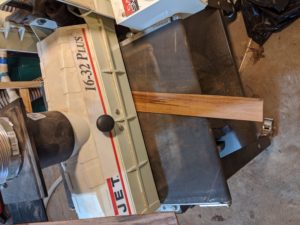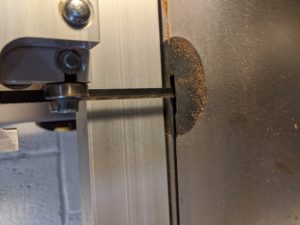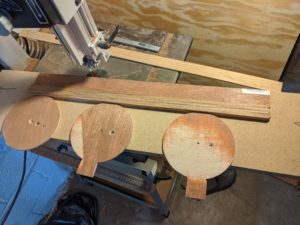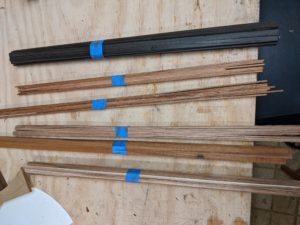I am taking a bit of a break from actual building, given the demands of a new old house, over-grown gardens, and a little carpal tunnel flare-up. But I have decided to at least make parts, enough so I don’t have to worry about having them around when I get back to building instruments.
I cut my own bindings, for a number of different reasons. To purchase them can get expensive, I can make them up with different and more interesting woods, I can experiment with different woods that are not at all commercially available. To this end I have a collection of pieces of wood to make into bindings. Off-cuts from making sides/backs, odd things I have purchased, stuff from the way-back collection, etc. The process of making bindings is as follows.
First the wood is sawn on the big bandsaw into thin pieces. These are then run through the thickness sander to remove the saw-marks and get the thickness down the .08 – .09 inches, which is my standard binding thickness.
Once the piece is the correct thickness (I do a bunch at once) they are ready to be sawn into binding. I do this on my small inexpensive bandsaw which is just right for light sawing. I use a sawblade with 35 teeth/inch. It is actually a metal cutting blade, but it saws wood just fine, and the fine teeth do a nice clean job on the strips of thin wood.
Once things are cut up into binding strips, one has to deal with the saw marks on the edge of the binding left from the above saw. The binding edge must also be smooth and square to the face so that when it is glued into the ledge routed for the binding in the side of the instrument it fits with no gaps.
To process the edge I made up a board with a straight edge and three circles out of 1/8″ plywood that are screwed down with off-center screws. By rotating these off-center circles I can clamp a set of bindings vertically against the straight edge.
With a whole bunch of binding clamped into the jig, I run it through the thickness sander. This sands the edge smooth, flat, and right angles to the binding face. I then flip the set of bindings over, and do the other edge. The result is a whole set of bindings that are completely uniform in height, with nice sharp square edges.
I keep the set together so that when choosing binding for an instrument one gets a set that are uniform in height. Different colors of koa and black bog oak here.




